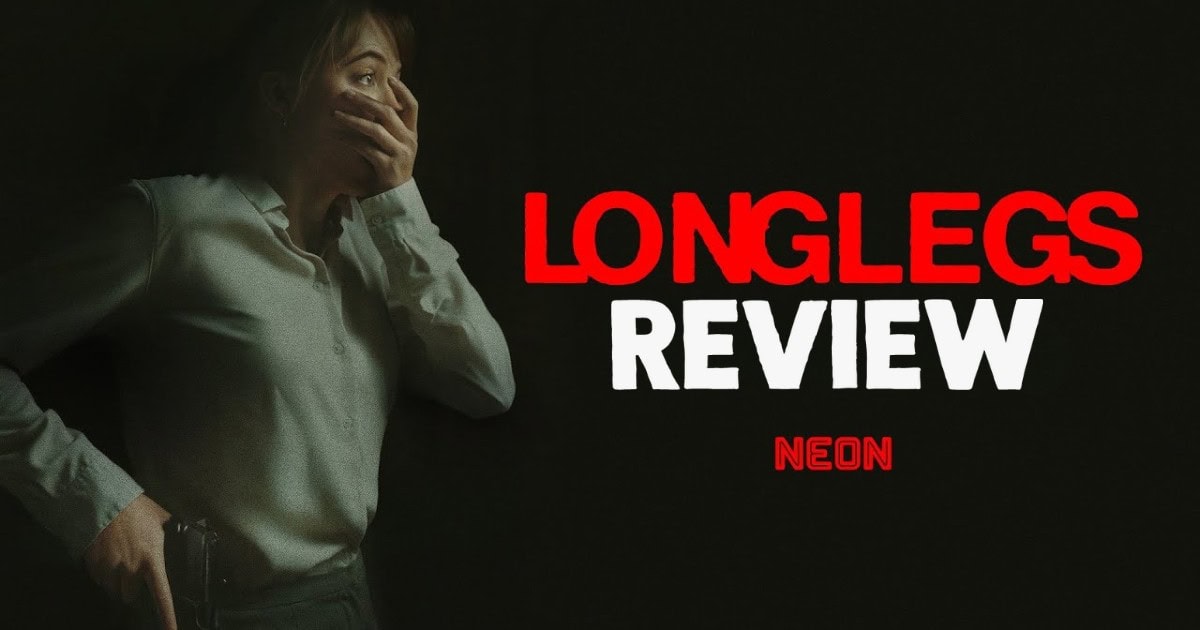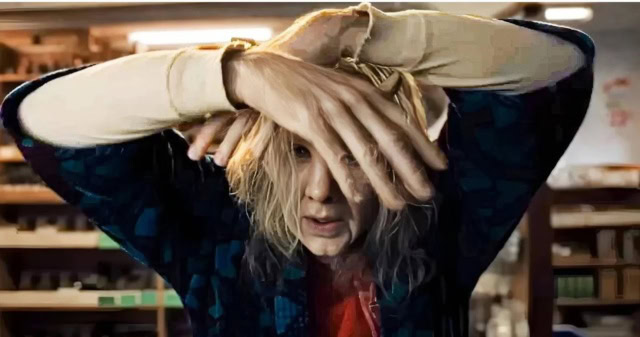Review: ‘Longlegs’ is the Silliest Horror Film of the Year

It will be very hard to talk about Osgood Perkins‘ latest film, Longlegs, without revealing a single element from its story and characters. From my understanding (I don’t watch trailers when they drop online, only when they appear in front of movies I see in cinemas), the marketing has shrouded its story and Nicolas Cage‘s role in secrecy. It even censored his face with a black box to keep his appearance as Longlegs a mystery until the audience sits in the theater and witnesses it for the first time. It’s an ingenious tactic because few trailers nowadays want to be mysterious. They prefer to reveal everything or paint a far different film than the finished product. This approach dissuades the audience from wanting to see a film as cold as possible.
This marketing tactic worked in the film’s favor, as buying a ticket to see it in sneak previews is currently impossible. Due to Mother Nature flooding Montreal highways, I had to wait one more day to finally see the horror movie everyone has been touting as “the scariest film of the year,” and a serial killer thriller on par with Jonathan Demme‘s The Silence of the Lambs. (Michael Mann‘s Manhunter is a superior film in every conceivable way, but that’s a story for another time). And when the film began in a 1.33:1 aspect ratio, briefly showcasing Cage‘s physical transformation as Longlegs, before cutting to its red title card sequence slowly expanding in its ultra-wide 2.39:1 frame, my interest was piqued.
We then meet our protagonist, Lee Harker (Maika Monroe), an FBI agent tasked by Agent Carter (Blair Underwood, always terrific) to solve a series of killings by a Satanic worshiper known as “Longlegs” (Nicolas Cage). The conceit is simple enough, and murders begin to pile up as she gets closer to catching Longlegs, who has been playing with Harker all along. He’s been sending cryptic letters to her house and talking to potential suspects she will soon be interrogating. This makes the game of cat-and-mouse fairly interesting, since the antagonist is always one step ahead of Harker, who is constantly (and unknowingly) falling into his trap.
[Warning: mild spoilers discussed for Longlegs below!]
Longlegs has many stylistic inspirations that go nowhere
That’s about as far as I can go without revealing a single element of its plot. It begins as a Kiyoshi Kurosawa-esque detective procedural with a clinical aesthetic reminiscent of the cinematography Jeff Cronenweth put forward in David Fincher‘s The Girl with the Dragon Tattoo.
The ultra-wide tracking shots of Harker hunting down Longlegs with her relentless hyperventilating, scared out of her mind, are immaculate to observe on the big screen. Perkins and director of photography, Andrés Arochi, create an enveloping aesthetic designed to crawl under your skin as more revelations on the killer arise. It makes perfect sense to be as wide as possible and constantly play with a background designed to eat its characters up as they position themselves within the frame.
But why does it insist on taking such a silly direction with an enveloping visual and aural aesthetic like this and a conceit that could potentially rival the greatest serial killer movies ever made? Never mind the blatant references to better filmmakers that Perkins can’t appropriate effectively and wear on his sleeves to create his own singular style. No, Perkins‘ major problem is that he can’t seem to focus on one specific storyline, which, in this case, is the descent into literal and figurative madness for Harker as she tries to uncover Longlegs.
This character study made a film like The Silence of the Lambs effective. Jodie Foster‘s Clarice Starling is at the front and center of the picture, descending further into the rabbit hole while hunting down a serial killer. This obsessive chase in tracking down the killer at all costs before any more innocent lives are at stake consumes the protagonist whole. Seeing it fully realized on screen makes the entire thing scary, especially when the agent unknowingly plays into the killer’s hand.
In that regard, Perkins starts his film with that approach in mind: Harker has sleepless nights over Longlegs, obsessively attempting to decipher his coded letters and figure out who he is before he makes his next move.
As further details are (badly) revealed, Perkins decides to forego this arc and morph the movie into a study of Satanic worship. This isn’t entirely bad, but he never delves deep enough into the subject to truly envelop us in the antagonist’s obsession with such a demonic figure. An FBI officer says to Harker (and us) that “Satanic worship isn’t illegal in the United States,” and that’s about as far as it goes before switching another gear by focusing on Nicolas Cage‘s character, doing… whatever the hell he’s doing.
Even Nicolas Cage can’t save this film
The entire marketing campaign of Longlegs has been built around the idea that “you’ve never seen Nicolas Cage like this,” hiding him at every turn for a performance so terrifying it must be seen to be believed. Whoever developed this marketing tactic is clearly a genius because you have seen Nicolas Cage like this in countless other movies. Only this time, it’s as if Tommy Wiseau became Marilyn Manson. That’s Longlegs.

And there isn’t a moment where it’s working. Not even during a tense interrogation scene between Harker and Longlegs (which apparently made Maika Monroe‘s heart rise to 170bpm!), which leads to the single worst decision the film could do to dampen its character study on a detective consuming herself by the burden of this case.
Cage‘s comical performance is a bad omen for the rest of Longlegs, derailing into even sillier, inexplicably uninteresting territory. Instead of slowly creeping into a powerful reveal, Perkins presents a twist so profoundly misguided and badly stitched together that it completely sinks what the half-baked character study was leading toward. It surely gives the movie a sharp turn, but an entirely unwelcome one, especially when the aesthetic has been this calculated.
This entire climax feels like it belongs in a different, entirely new movie, where Satanic worship consumes our souls into darkness instead of Harker’s obsession with the case. Perhaps some will say they communicate with each other. This could be an argument made if the ending didn’t become so spiritual when the film slightly twists Biblical imagery and mostly strays away from it, but never in such an in-your-face way as the last few scenes do.
But it’s also hard to discern exactly what Longlegs is talking about when Perkins doesn’t develop any of the storylines he presents on screen, even from a visual perspective. The clinical aesthetic works when the film is a full-on police procedural, but the 16 mm parts act more like distracting flourishes than enrapturing Harker’s path into obsession. And when the central protagonist is barely developed past her fear and anxiety-riddled self, one can’t expect the antagonist to be properly fleshed out either. Even if Cage tries his damnedest to be ultra-expressive but fails even to draw one moment that doesn’t feel like an unintentional gag.
As a result, Perkins‘ ambitions fall way short of meeting any form of expectations. This has plagued all of his filmography, from the poetically dull I Am the Pretty Thing That Lives in the House to the ridiculous The Blackcoat’s Daughter.
He presents an enrapturing visual style with each picture. This sets an atmosphere designed to crawl under your skin. However, he can’t execute this setting properly because he’s constantly deviating his simple premises for silly reveals and poorly thematic underpinnings. It didn’t work in his previous films and still doesn’t work in Longlegs.
Here’s hoping his next film, The Monkey, will combine strong images with an enveloping story and potent themes. I’ll be waiting and watching, but my expectations will remain in check.
Longlegs is now playing in theaters. Let us know what you think of the movie on social media @mycosmiccircus!
Maxxxine: Mia Goth & VHS Scuzz Mark a Gloriously Salacious Final Chapter



